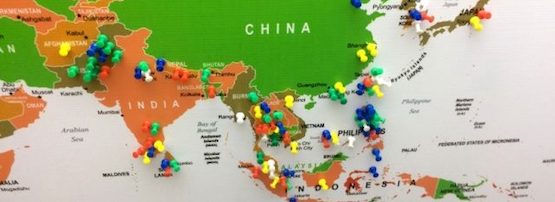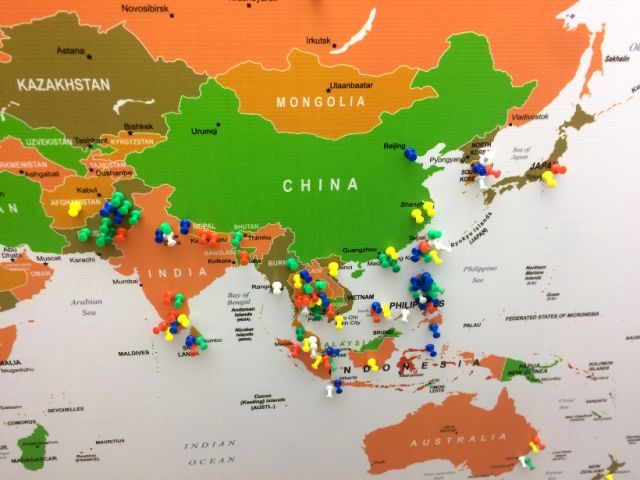
Bangkok hosted the 2017 Asia Pacific Regional Internet Governance Forum (APrIGF), held from 26 to 29 July.
More than 400 international participants from 44 economies joined 300 local attendees for the four-day annual forum to discuss and share Internet governance issues from the Asia Pacific region — encouragingly, over 40% of the crowd was female.
From the APNIC community, engineers from bdNOG contributed in several technical discussions, as did private sector Members — including Softbank BB, which shared its IPv6 deployment case study — and staff members from several regional NIRs and APNIC (including APNIC EC members).
Following a warm welcome from local host Dr Bundhit Eua-arporn, President of Chulalongkorn University, the forum began with a presentation from Paul Wilson, APNIC Director General and outgoing APrIGF Multi-stakeholder Steering Group Chair, who introduced the concept and key themes of the 2017 APrIGF Synthesis Document.
The Synthesis Document aims to document items of common interest relevant to Internet Governance in the Asia Pacific region and is open for people to contribute prior to, during and after the APrIGF meetings.
The main theme of this year’s APrIGF was “Ensuring an inclusive and sustainable development in Asia Pacific: A regional agenda for Internet governance”, and included the following four sub-themes that formed the basis of the agenda for the forum:
- Access, Empowerment and Diversity
- Cybersecurity, Privacy and a Safer Internet
- Digital Economy and Enabling Innovations
- Human Rights and the Internet
Below is a summary of the key points discussed in relation to these sub-themes.
Access, Empowerment and Diversity
- Greater access to ICT options for remote areas, particularly smaller Pacific Island nations, was again high on the agenda. Overall, connectivity in the Asia Pacific region is around 40% to 50%, but this figure is a lot lower for small island nations.
- Specific initiatives that are seeking to improve connectivity in this region, which caught my attention, included Tonga’s commitment to developing a fibre optic cable backbone; Vanuatu’s target to connect 90% of its population by 2020; and Fiji’s Connectivity Project, which aims to reduce the cost and increase the availability of Internet services in the country.
- Access to IPv6 was also discussed under this theme, during the session “National policies and Industry strategies on IPv6 in the Asia Pacific region”.
Cybersecurity, Privacy and a Safer Internet
- There are various new regulations that are being developed to improve the public’s privacy and safety on the Internet; however, many have caused confusion among businesses. While large organizations have had the resources to be able to adapt to these regulations, many small and medium-sized enterprises have found such restrictions constricting.
- Transferring data from one country to another other should be easy, but in reality, it is complicated due to various regulations — there is no dialogue or comprehensive set of rules that accommodates free flow of data.
Realization of the digital economy and innovation
- In recent years, there has been a tendency for governments to relax restrictions in a bid to cultivate a digital economy without giving much thought on how this will disadvantage those who don’t have access to the Internet.
- Private companies have access to an unprecedented amount of privacy data; however, many of the privacy rights apply only to governments. Therefore, governments use these private companies as proxies.
- It is possible to create an environment that promotes innovation by law — for example, creating appropriate tax incentives to encourage business and entrepreneurs to invest in and develop such an economy.
For years, there have been prolonged discussions between the Thai government and content providers related to the need to regulate the Internet and social media.These discussions have become much broader now and encompass the need to regulate sharing-economy services and similar Over the Top (OTT) services.
As one Thai government representative pointed out, the need for government to adopt a multistakeholder approach to these discussions is as important as ever, given how these new services are blurring the lines of traditional industries and their historical regulations. However, the concept of the model is very abstract for them, which is why they were interested in learning more at the APrIGF about how governments can work with other stakeholders on these issues as well as other Internet governance topics.
Human Rights on the Internet
The human rights of Internet users are as exposed to threats as ever, particularly in three areas:
- Influence in offline: Internet anti-censorship activists have become targets because they express their opinions online — this is a serious issue in South Asia.
- Privacy and data protection: Some governments in the region have introduced National ID systems that have inadequate privacy protection measures compared to best practices that are being strengthened in other regions, particularly in Europe.
- Gender and sexuality: This is not only a problem of protecting women from physical abuse, but is becoming more so about protecting them from psychological abuse. This also includes women’s rights to access the Internet, which is also a form of censorship; and as such should not be dismissed as only a matter of gender.
If we want to bring everyone online, what kind of ‘online’ are we bringing them into – @MalJayaram at #APrIGF re. online harassment pic.twitter.com/om9Yaln58u
— Code for Pakistan (@CodeforPakistan) July 27, 2017
National Regional IGF Initiatives
There are seven national IGFs in the Asia Pacific that are registered in the UN global IGF (Afghanistan, Bangladesh, China, Indonesia, Japan, Nepal, and Sri Lanka), as well as Taiwan IGF, which is very active.
Read: TWIGF provides opportunity to discuss local Internet issues
Representatives from each of these national IGFs met during the meeting to discuss and agree on the need for a collaborative mailing list and Wiki to exchange information and communicate with one another.
Get involved!
If you were not able to attend APrIGF 2017, or missed a particular session of interest, you can find videos or the sessions on the APrIGF 2017 YouTube Channel.
If you want to read and/or contribute your thoughts on these four sub-themes discussed at this year’s forum, a first draft of the Synthesis Document will be open for comments until 4 August here, as will a second draft, which is planned to be open 16-31 August for further public input before final synthesis in September. For more details, see here.
Post adapted from original article on JPNIC Blog
Izumi Okutani is the Policy Liaison at the Japan Network Information Centre and a member of the APNIC Executive Council.
The views expressed by the authors of this blog are their own and do not necessarily reflect the views of APNIC. Please note a Code of Conduct applies to this blog.

